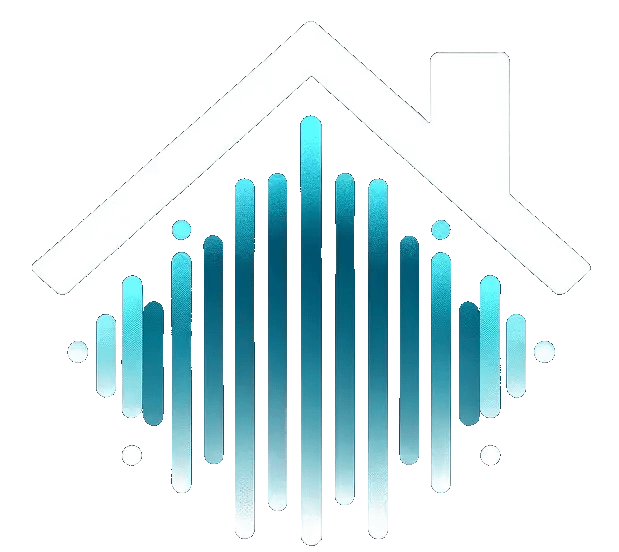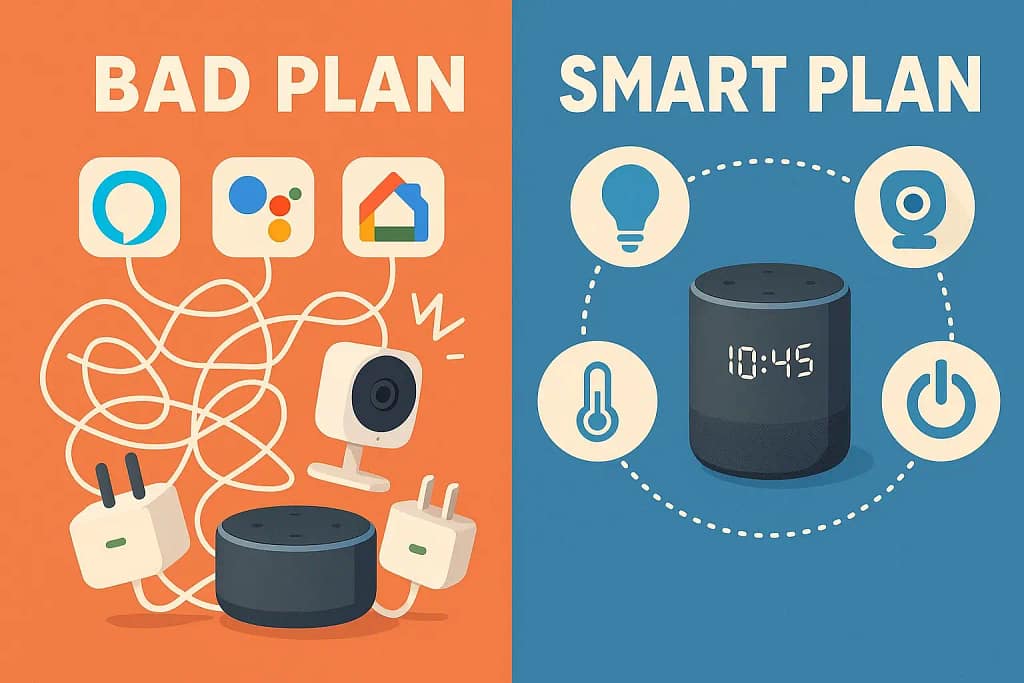Planning a smart home can feel overwhelming—especially with so many options on the market. But with the right approach, you'll avoid costly mistakes, buy only what you need, and build a setup that's future-proof and efficient.
Welcome to your ultimate smart home planning guide. Whether you're just starting or looking to expand your setup, this post walks you through each critical step—from choosing an ecosystem to budgeting, compatibility, setup, and automation.
As a real-world example: my smart home started with a Ring camera to monitor packages at the door, an Echo Show 8 to play music while I cooked, and Govee lights synced to a gaming scene. Yours might look different—but with the same foundational plan, you'll save time and money.
Step 1 – Power Up Your Smart Home: Pick Your Perfect Ecosystem
One of the first things to do when planning your smart home is to choose the right ecosystem. That means picking between Amazon Alexa, Google Assistant, or Apple HomeKit—the digital assistant that will connect and control your devices.
| Ecosystem | Strengths | Limitations |
|---|---|---|
| Amazon Alexa | Most compatible devices, great routines | Interface can feel cluttered |
| Google Home | Excellent voice recognition, clean UI | Limited third-party skills |
| Apple HomeKit | Strong privacy, great for iPhone users | Fewer supported devices, higher cost |
What About Matter?
Matter is a new smart home standard that all the big tech companies support. Think of it like a universal translator for smart devices—it helps gadgets from different brands work together. So, if you buy a sensor that works with Matter, it should connect with both Alexa and Apple Home, even if those systems are usually separate.
If you're starting fresh, buying Matter-compatible devices ensures better long-term flexibility—especially as new devices enter the market.
Step 2 – Map Your Smart Home: Room-by-Room Device Planning
The best way to avoid buying things you don't need? Plan by room. Below is a guide to what most people automate, plus ideas for devices that offer the best bang for your buck.
Living Room
- Smart lights (e.g., Philips Hue, LIFX)
- TV control via smart remotes or voice
- Streaming sticks (like Fire TV, Chromecast)
- Smart speakers or soundbars (Sonos, Echo Studio)
Kitchen
- Echo Show 10 or Nest Hub for recipes and timers
- Smart plugs for coffee makers or air fryers
- Smart speaker for news/weather/music
- Example: My Echo Show 8 gives me cooking timers, news updates, and weather alerts every morning while I prep breakfast.
Bedroom
- Smart bulbs with sleep/wake routines
- Smart alarm clocks (Hatch, Echo Dot w/Clock)
- Temperature sensors or smart thermostat zones
Bathroom
- Motion-activated lights
- Bluetooth smart speaker (waterproof)
- Smart scale or mirror
Garage / Outdoor
- Smart garage door openers (MyQ, Tailwind)
- Outdoor cameras and floodlights (Ring, Arlo)
- Smart irrigation systems (Rachio)
Security (Indoor/Outdoor)
- Video doorbells (Ring, Nest, Eufy)
- Smart locks (August, Schlage)
- Contact sensors for doors/windows
- Motion sensors + alarm integrations
Step 3 – Budget Like a Pro: Smart Home Cost Breakdown
One of the most common questions when learning how to plan a smart home is: "How much does it cost?" Here's a breakdown by budget tier:
| Budget Tier | What You Get | Best For |
|---|---|---|
| $500–$1,000 | Starter pack: bulbs, plugs, speaker, doorbell cam | Renters, first-time users |
| $1,000–$2,500 | Add thermostats, sensors, multiple rooms | Small homes, new homeowners |
| $2,500+ | Whole-home automation, high-end AV + security | Families, long-term investments |
Sample ROI Breakdown (Annual)
| Upgrade | Avg Cost | Annual Savings | ROI Timeframe |
|---|---|---|---|
| Smart Thermostat | $150 | $100–$150 | 1–2 years |
| LED Smart Bulbs (10 pk) | $120 | $75–$100 | 1.5–2 years |
| Smart Plugs (4 pk) | $50 | $30–$50 | 1.5–2 years |
| Energy Monitoring System | $250 | $100–$200 | 1–2.5 years |
💡 Tip: Start with devices that save energy. They're easier to justify and often pay for themselves.
Step 4 – Future-Proof Your Setup: Smart Home Compatibility Guide
As you expand, compatibility becomes critical. Here's a quick smart home compatibility checklist to avoid frustration down the line.
Protocol Comparison Table
| Protocol | Range | Speed | Mesh Support | Use Case Examples |
|---|---|---|---|---|
| Wi-Fi | High | Very Fast | No | Cameras, speakers |
| Zigbee | Medium | Fast | Yes | Sensors, lights, switches |
| Z-Wave | Long | Moderate | Yes | Locks, motion detectors |
| Thread | Medium | Fast | Yes | Matter-enabled devices |
| Bluetooth | Short | Slow | No | Scales, headphones |
Hub vs Hubless
A smart home hub acts as a central control point. Hubless setups are simple but can become laggy. Hub-based systems (like Zigbee, Z-Wave, or Thread) are more scalable and reliable.
Beginner Tip: Hubless works for 5–10 devices. More than that? Consider a hub like Hubitat or HomePod Mini.
Step 5 – Installation Made Easy: Smart Home Setup Guide
- ✅ Stable Wi-Fi coverage
- ✅ Dual-band router (2.4 GHz for smart devices)
- ✅ Download companion apps (Alexa, Govee, Ring, etc.)
Basic Electrical Safety
- Turn off power before wiring
- Label wires clearly
- Hire a pro if unsure
Wi-Fi Optimization
- Use 2.4 GHz for smart plugs, sensors, bulbs
- Consider a mesh system for larger homes
App Setup Tips
- Group devices by room
- Use logical naming ("Kitchen Light", "Front Door Cam")
- Test voice commands and routines early
Step 6 – Master Your Smart Home: Automation & Scenes
Sample Routines
- Morning: Fade-in lights, Echo Show news, coffee plug ON
- Away Mode: Lights off, locks engaged, camera armed
- Night Mode: Thermostat down, lights dimmed, sleep scene
- Game Mode: Govee LEDs + soundtrack triggered via Alexa
Common Smart Home Mistakes to Avoid
- Buying random gear without checking compatibility
- Bad Wi-Fi limits everything. Fix your foundation first
- Poor naming ruins voice control usability
- No growth plan – avoid one-off gadgets
- Over-automation – test in small steps
FAQ
Can I mix Alexa and Google devices?
You can, but it’s messy. Use Matter-compatible devices to bridge the gap.
Should I wait for Matter?
No need to pause your setup—just buy Matter-ready devices when possible.
Final Thoughts
With the right strategy, your smart home can grow naturally without breaking the bank. Prioritize compatibility, build routines that simplify life, and expand with confidence.
Need help choosing your first device? Check out our Smart Home Starter Tool.
As an Amazon Associate I earn from qualifying purchases.

